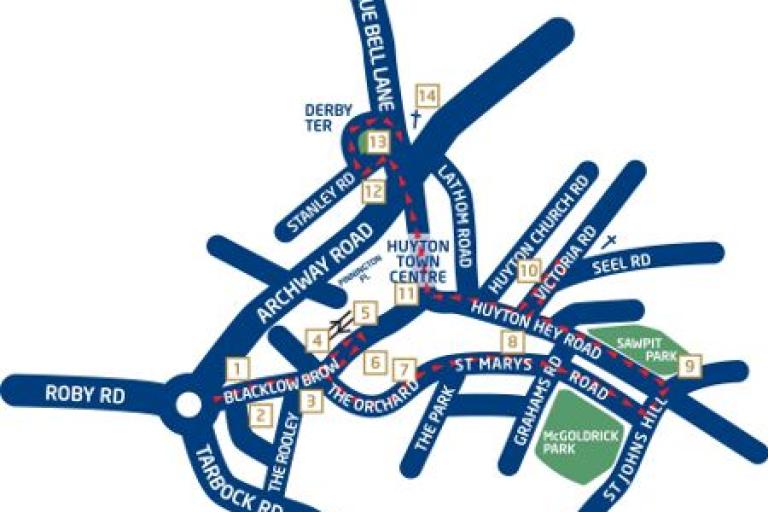Huyton
Huyton is of ancient origin and is mentioned in the Domesday survey of 1086 as Hitune, possibly meaning 'High Town'. Over the centuries, several notable families have owned it: the Lathoms, the Stanleys (the name of the Earls of Derby), and the Molyneux-Seels. At one time, the area was heavily forested and later became agricultural.
The introduction of the Turnpike Trust in the early 18th century resulted in the building of a road from Prescot to Liverpool. The world's first passenger railway from Liverpool to Manchester in the 19th century brought further change. The branch station opened in Huyton in 1872, making Huyton a popular location for several villa estates.
In the mid-20th century, further land in and around Huyton was developed to address the demand for housing from the overflow population in Liverpool's urban areas.

The route:
- On Archway Road, once known as Sandpit Lane, you can see the Grade II listed Railway Bridge. When the foundations were being dug for the bridge, the remains of a vessel were found, probably Viking in origin.
- On the right-hand side of Blacklow Brow it was used to be the Ewanville estate, which extended from the bottom of Blacklow Brow to The Rooley. Ewanville was the home of the Beecham family, founders of the famous pharmaceutical firm. One member of the family, Sir Thomas Beecham, was a world-famous conductor. The house was demolished in 1933 to make way for the housing that can be seen today.
- The Rooley was a small pathway until 1897 when it was adopted as a public road. The name derives from 'Roolowe', which was recorded in a document from 1343.
- The Queens Arms has an interesting history. It was once the site of a row of shops patronised by servants from Knowsley Hall who would travel by horse and cart. It was also a lodging house that accommodated the workers building the railway.
- Huyton railway station was initially called Huyton Gate and is one of the original stations on the historic Liverpool to Manchester line. Royalty came frequently to this station when staying at Knowsley Hall, and it was customary for the stationmaster, in top hat, to greet them and precede them out by walking backwards.
- Huyton Hall was once a successful girls' school, Huyton College, founded in 1894. The college motto was 'Fideliter Fortiter Feliciter, (Loyalty, Pluck, Cheerfulness).
- The Orchard is a gently curving, tree-lined road with various imposing residences built for colliery owners, shipowners and merchants. It was one of Huyton's wealthiest developments. Greenhill was the home of Lord Cozens-Hardy, and Beaconsfield had two tennis courts, an orchard, a playing field and gardens set in four acres of land.
- In St Mary's Road are many fine houses, and the deeds of some strangely forbade the "curing of kippers", "strawberry garden parties", and "traction engines". Of interest are numbers 20 and 22 and number 58a, an old coach house and number 60a, old stables.
- Huyton Hey Manor was originally a farmhouse dating from 1670 and is Huyton's oldest surviving secular building.
- Victoria Road, part of another of Huyton's conservation areas, has the character of a Victorian suburb and contains some grand houses, for example, Newlands and Hollinside. Also of note is the Grade II listed Huyton Reformed Church, built in 1890 and influenced by Truro Cathedral. Park Hall, the original Congregational church, is also Grade II listed, of neo-gothic design and built in 1856 with stone from the Huyton quarry.
- The statue is of Harold Wilson of Rievaulx, who was Prime Minister of Britain and Labour MP for Huyton for 33 years. Tom Murphy was the sculptor.
- Whilst the 19th century saw much development of villa dwellings in Huyton, modest terraced housing was also provided. Examples of these are the mock Tudor cottages along Blue Bell Lane and the houses on Derby Terrace and Stanley Road.
- Huyton Cross was erected in 1897 to commemorate Queen Victoria's Jubilee. This was once the village green and was a popular spot for cock fighting and bull-baiting. This was eventually stopped by the vicar of St. Michael's Church, who erected the original cross in 1819 to prevent such activity.
- St. Michael's Church is Grade II* listed and dates back to the 12th century and, over time, has been altered and extended. Inside the church is an early Norman font, a chancel screen dating from 1460 and a 14th-century effigy of a priest, probably John de Winwick. The gateways, both listed, are constructed of stone with wrought iron piers and dated 1765.